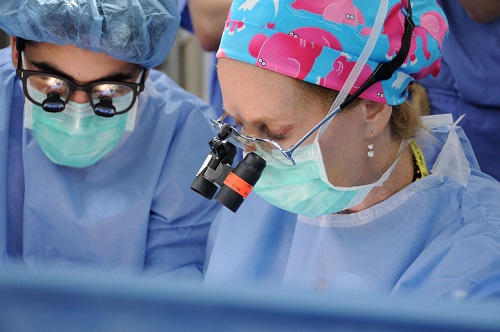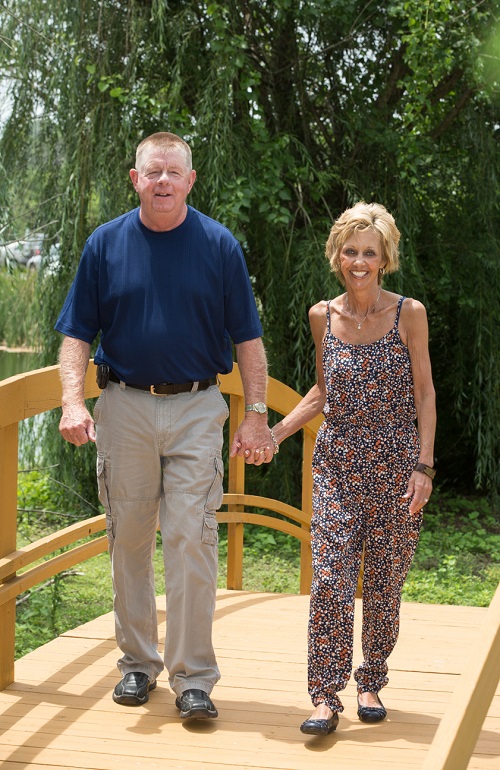Nearly 400,000 people are impacted by nerve injuries each year. Yet, peripheral nerves—nerves in the arms and legs—are often overlooked by medical specialists.
It’s an orphan specialty, says Susan Mackinnon, MD, a nerve repair specialist at Barnes-Jewish Hospital and the Washington University chief of plastic and reconstructive surgery. And there is a persisting belief by some within the medical community that treatment options for nerve injuries are limited—that patients just have to “live with it.”

Dr. Mackinnon is doing all she can to change this perception. She’s dedicated her career to one tireless mission: improving outcomes for nerve injuries through innovative techniques and research.
As a result, she has the skills few have and the expertise that gives hope to patients who don’t want to “live with it.”
Two of these patients experienced years of unrelenting leg pain. After many unsuccessful treatments and surgeries, they had to leave behind the activities they loved the most.
The frustration of not being able to identify the source of the pain—or to fix it—seemed never ending. But it all changed when they were referred to Dr. Mackinnon.
With her unique medical expertise and focus on the peripheral nerves, Dr. Mackinnon diagnosed the root of their nerve pain and provided the treatments that gave them instant relief and a return to the lives they loved.
RUNNING TO FIND ANSWERS
McKenzie Ozee had been suffering knee pain for the last three years of high school. It was so intense it began to jeopardize her athletic performance and her hopes to continue running on her school’s track team.
 McKenzie’s orthopedic surgeon in her hometown of Springfield, Mo., performed a procedure to remove a plica, a fold in the protective tissue around the knee that was a potential source of her knee pain.
McKenzie’s orthopedic surgeon in her hometown of Springfield, Mo., performed a procedure to remove a plica, a fold in the protective tissue around the knee that was a potential source of her knee pain.
McKenzie still experienced intense pain after the surgery. She was told there was nothing structurally wrong and was cleared to continue running. If the pain got too bad, they said it was time to quit the sports she loved.
“I felt the only answer people were giving to me was to quit—and I don’t like quitting,” she says.
So, McKenzie didn’t give up. She was referred to Dr. Mackinnon at Barnes-Jewish Hospital to find answers.
SEEKING A SOLUTION
Meanwhile, Delanna Burbridge of Branson, Mo., had been a healthy, active woman just three years ago. She enjoyed frequent two-mile walks and other exercise.

"Walking three or four miles is now a simple task...
There's no stopping me." |
As a self-described “overachiever,” Delanna pushed herself physically. A torn meniscus, a ligament in the knee, finally slowed her down. It also was the event that led to cascading problems with her leg.
She first had surgery at another hospital to repair the meniscus and remove a cyst behind her knee. She was left with lasting pain and weakness due to a compressed nerve. A condition called drop foot, in which the foot can’t flex up and down, caused her to fall and further damage her nerve. A second surgery left her at a crossroads with even more intense pain.
Days with limited mobility followed by sleepless nights in pain became the new normal. “Beyond not being able to walk or exercise, I couldn’t babysit my grandchildren anymore,” Delanna says. “I couldn’t go shopping, or go places together with family like ball games or date nights with my husband. I could barely walk without the unbearable pain and the constant worry of stumbling or falling. At that point we were desperate.”
She needed answers. Her orthopedic specialist recommended Dr. Susan Mackinnon who specializes in complex nerve injuries.
And like the many other patients who come to see Dr. Mackinnon, Delanna sought a solution to give her back the life she longed for.
HOPE FOR PATIENTS WITH NERVE INJURIES
McKenzie and Delanna had come to the right place. Their pain was directly related to nerves.
“Dr. Mackinnon explained in detail where I was hurting and why it was hurting the way it was,” Delanna says. “After that first exam, my husband and I both knew I was finally going to get some help. A huge weight of worry was lifted that day, even before my surgery, just knowing we finally found a doctor who understood my pain.”
With both McKenzie and Delanna, Dr. Mackinnon was able to isolate the source of the compressed nerve and diagnose the injuries using an innovative physical test that she pioneered: the hierarchical scratch collapse test.
During the exam, the patient sits with arms bent at a 90-degree angle toward the chest. Dr. Mackinnon applies pressure to the arm, and gently scratches the skin overlying a nerve. She then applies pressure once again. If the arm collapses, she knows she has correctly “scratched” and isolated the compressed nerve. By using a topical anesthetic, Dr. Mackinnon can “freeze out” particular nerves to identify secondary compressed nerves.
The test requires extensive knowledge of the surface anatomy of each nerve that few specialists have.
“It was awesome to see Dr. Mackinnon work and watch her mind go,” says McKenzie’s mother, Michelle.
“Her experience is better than any machine or test. She’s really passionate about her job and cares about her patients.”
After correctly identifying compressed nerves for both Delanna and McKenzie, Dr. Mackinnon performed surgery to release the nerve so it could begin to heal.
MOVING TOWARD A PAIN-FREE FUTURE
Today, McKenzie and Delanna are back to the lives and activities they love. They speak of almost immediate relief following Dr. Mackinnon’s surgery. “I had been in pain for three years before she operated,” Delanna says. “It was amazing to lay in the hospital bed and know that the deep, unbearable pain was gone even right after the surgery.”
She continues: “Dr. Mackinnon’s expertise greatly improved my quality of life. I can do things with my grandchildren and family again. Walking three or four miles is now a simple task. It’s a completely different world to be pain-free. There’s no stopping me.”
In August 2015, McKenzie became a student at Missouri State University. Ultimately, McKenzie would like to become a physical therapist so she can help patients like herself.
“The surgery improved every aspect of my life, not just running,” she says. “I was able to participate in my senior high school track season pain-free. The emotional experience of being able to do something I love again brought everything into perspective.”
A PIONEER IN NERVE TREATMENT
Throughout her career, Dr. Mackinnon has helped usher in dramatic shifts in the way nerve injuries are treated. She performed the first donor nerve transplant in 1988 and is an international leader in nerve regeneration and nerve transfer—techniques that restore function to limbs that formerly would’ve been lost forever.
McKenzie’s and Delanna’s recoveries seem remarkable, but they aren’t uncommon results for Dr. Mackinnon. And the lifesaving innovations Dr. Mackinnon has made wouldn’t be possible without the generous support of donors.
Donors to The Foundation for Barnes-Jewish Hospital provide vital support for Dr. Mackinnon’s research as she continues to seek ways to improve treatments for patients with nerve injuries and to share her knowledge and expertise with other physicians.
To support Dr. Mackinnon’s research, please make a gift to the Peripheral Nerve Research Fund by calling 314.286.0600.